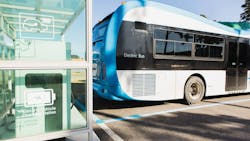Preparing for the electric revolution
With transit providers continuing to shift toward alternative fuel and electric vehicles, the impacts are not only felt among fleets, but within operational models, as well. Ann Derby writes that starting with a good plan can help an agency navigate the potential risks and take take full advantage of the benefits offered by these vehicles.
Why it matters
According to the California Air Resources Board (CARB), 40 percent of climate-changing gas emissions and 80-90 percent of smog-forming pollutants are produced by the transportation sector.1 Public transit advocates have long been aware of these impacts and are continually working to reduce the impact fossil fuels have on our environment. Already, a massive migration to alternative fuel and electric vehicles is taking place.
For agencies entering the electrification process, the journey can be question-filled, especially because it requires an operational paradigm. That’s because the introduction of electric vehicles affects every aspect of a public transit agency’s operation - planning, fleet monitoring, charging and range management, personnel requirements and depot infrastructure to name a few.
It starts with planning
The challenging scenarios e-buses present require altered or redesigned planning processes. For instance, determining which routes the vehicles will operate on and what the topology of the routes are is critical because battery energy will drain faster if the route is hilly - versus primarily flat roads.
Understanding the type and range of the battery is also important because it will determine whether the vehicle will be able to complete the distance of the block before needing to be recharged. Passenger loads and environment must also be taken into consideration. More riders will cause the vehicle to consume more energy, as well as extreme temperatures because the vehicle will require the use of air conditioning or heating.
Charging scenarios
Determining when and where to charge vehicles is important, especially when it comes to avoiding high peak periods when electricity is most expensive.
Where the vehicles can charge will be dependent on existing infrastructure and the length of the block. If vehicles must be charged en-route, the charging station location must then be placed more strategically. If there are only a few vehicles, charging might occur at the depot, but this could result in more dead runs. Finally, as the fleet grows, additional charging stations must be added.
Simulating electric integration
The good news is, there are solutions to help mitigate the operational and economical risks associated with the introduction of electric vehicles. INIT has developed a simulation tool that helps agencies examine the various constraints, analyze the results and gain insight for short- and long-term planning decisions before implementation. By providing optimized timetables, blocks and schedules, agencies can discover the most cost-effective way to integrate electric vehicles into their fleets during the implementation phase, when the company typically has no historical data.
Benefits of the electric revolution
The move to electric vehicles is instrumental, not only for agencies but for their communities. Passengers enjoy greater health benefits through cleaner air quality, and transit agencies can feel good about reducing their footprint and the long-term savings on maintenance and fuel costs.
Preparing for the revolution means staying ahead of the curve. In the end, the move to electrification results in the kind of revolution we can all live with.
Ann Derby, CTSM , is the director of Marketing & Events at INIT.



